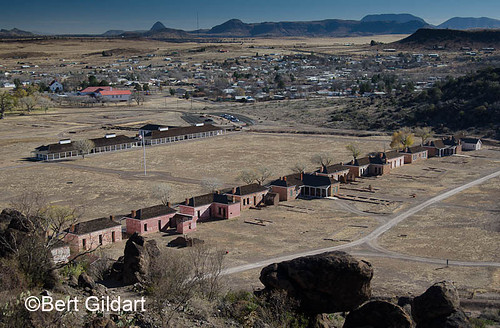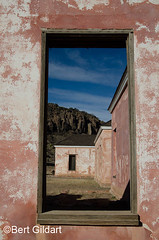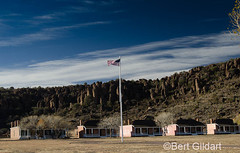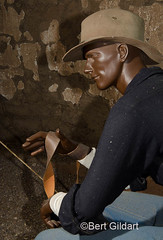Historic Ft. Davis – Making Claims to a Proud (mostly) History
©Bert Gildart: If you plant the image of the row of old adobe homes in your mind’s eye, then shut your eyes for a moment and then listen to blare of the trumpet playing revelry through the park’s much obscured PA system, it is easy to be transported back to the years between 1854 and 1891.
I was visiting Fort Davis, Texas, and it is one of the very best preserved old military complexes in the United States. Such integrity helps preserve old stories and they are still told here about the famous Indian leader, Victorio; about everyday life for soldiers on the frontier; about the Buffalo soldiers; and, sadly, about Henry O. Flipper – West Point’s first black graduate.
NATURE TRAIL
To better assimilate this parade of images, I had followed the advice of a park ranger and followed a nature trail to the top of a mountain of muscular rocks of volcanic origin. Along the way signs alerted me to materials used for constructing the fort, to wood used for heating the fort, to interpretations of how life in general unfolded for the men charged here to protect settlers moving into Texas.
Though the Comanches had been defeated in the mid 1870s, Apaches continued to make travel on the San Antonio-El Paso Road dangerous. Units from Fort Davis fought the crafty Victorio eventually forcing the Apaches into Mexico, where Mexican soldiers killed Victorio and his followers.
BUFFALO SOLDIERS
This lofty visage also offered the best views of the entire complex, which consisted of dozens of well-preserved old structures. Following the Civil War many of these buildings were occupied by Buffalo Soldiers, and here is where a story of tragedy begins to unfold.
L to R: Construction of military complex consisted of much adobe; showing parade grounds and segment of buildings yet remaining; “Buffalo Soldier”, men Indians named because of similarity in appearance of head hair (they thought) to wool of bison. They also called these men “worthy opponents.”
From 1870 to 1871 Henry Flipper was one of the black soldiers stationed at Fort Davis, and he became the victim of a conspiracy fomented by racist officers.
Though off the radar for most, I’ve known about the story for years, having heard it from my dad, himself a West Point graduate and a man who was proud of his knowledge of academy history. In 1881, while stationed at Fort Davis, Texas, Flipper was framed by white officers and charged with embezzlement. At his court-martial he was found not guilty of embezzlement but guilty of “conduct unbecoming an officer and a gentleman.” He was dishonorably discharged, and for the rest of his life he fought to restore his good name. Eventually he did.
The town surrounding us is also called Ft. Davis and we’ve parked our Airstream at an RV park named after the Butterfield Stagecoach Route. Essentially, winter is setting in making us one of the very few people now exploring this historic and quite picturesque area. Though this quiet time might not be for everyone, we absolutely cherish such times. However, if you dear reader are in the area, please look us up.
———————————-
AIRSTREAM TRAVELS FIVE YEARS AGO:
(Note: RV travelers might enjoy materials from both of these links!
—————–
4th ed. Autographed by the Authors
Hiking Shenandoah National Park
 Hiking Shenandoah National Park is the 4th edition of a favorite guide book, created by Bert & Janie, a professional husband-wife journalism team. Lots of updates including more waterfall trails, updated descriptions of confusing trail junctions, and new color photographs. New text describes more of the park’s compelling natural history. Sometimes the descriptions are personal as the Gildarts have hiked virtually every single park trail, sometimes repeatedly.
Hiking Shenandoah National Park is the 4th edition of a favorite guide book, created by Bert & Janie, a professional husband-wife journalism team. Lots of updates including more waterfall trails, updated descriptions of confusing trail junctions, and new color photographs. New text describes more of the park’s compelling natural history. Sometimes the descriptions are personal as the Gildarts have hiked virtually every single park trail, sometimes repeatedly.
Big Sky Country is beautiful
Montana Icons: 50 Classic Symbols of the Treasure State
![]() Montana Icons is a book for lovers of the western vista. Features photographs of fifty famous landmarks from what many call the “Last Best Place.” The book will make you feel homesick for Montana even if you already live here. Bert Gildart’s varied careers in Montana (Bus driver on an Indian reservation, a teacher, backcountry ranger, as well as a newspaper reporter, and photographer) have given him a special view of Montana, which he shares in this book. Share the view; click here.
Montana Icons is a book for lovers of the western vista. Features photographs of fifty famous landmarks from what many call the “Last Best Place.” The book will make you feel homesick for Montana even if you already live here. Bert Gildart’s varied careers in Montana (Bus driver on an Indian reservation, a teacher, backcountry ranger, as well as a newspaper reporter, and photographer) have given him a special view of Montana, which he shares in this book. Share the view; click here.
$16.95 + Autographed Copy
What makes Glacier, Glacier?
Glacier Icons: 50 Classic Views of the Crown of the Continent
![]() Glacier Icons: What makes Glacier Park so special? In this book you can discover the story behind fifty of this park’s most amazing features. With this entertaining collection of photos, anecdotes and little known facts, Bert Gildart will be your backcountry guide. A former Glacier backcountry ranger turned writer/photographer, his hundreds of stories and images have appeared in literally dozens of periodicals including Time/Life, Smithsonian, and Field & Stream. Take a look at Glacier Icons
Glacier Icons: What makes Glacier Park so special? In this book you can discover the story behind fifty of this park’s most amazing features. With this entertaining collection of photos, anecdotes and little known facts, Bert Gildart will be your backcountry guide. A former Glacier backcountry ranger turned writer/photographer, his hundreds of stories and images have appeared in literally dozens of periodicals including Time/Life, Smithsonian, and Field & Stream. Take a look at Glacier Icons
$16.95 + Autographed Copy





